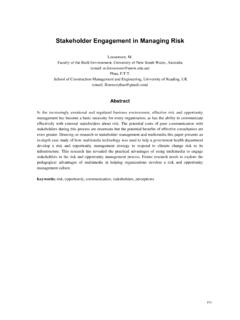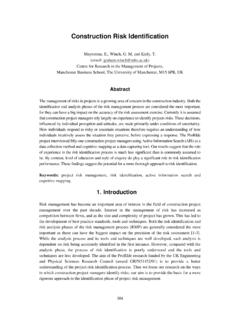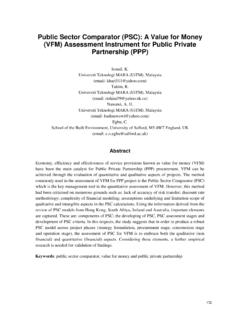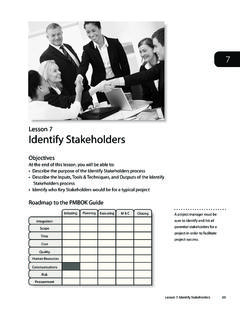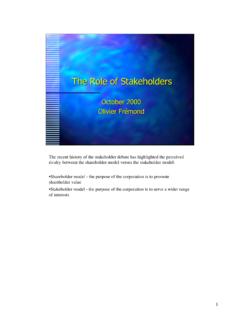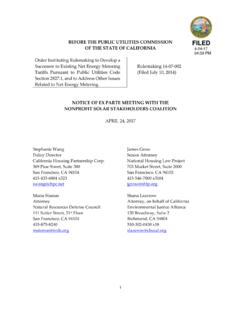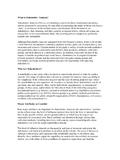Transcription of From Client To Project Stakeholders: A Stakeholder Mapping …
1 CIB W55 & W65 Joint Triennial SymposiumCustomer Satisfaction : A focus for research & practiceCape Town : 5-10 September 1999 Editors: Bowen, P. & Hindle, Client TO Project STAKEHOLDERS: A Stakeholder MAPPINGAPPROACHROBERT NEWCOMBED epartment of Construction Management & EngineeringThe University of Reading, Whiteknights, PO Box 219, Reading, RG6 6 AWFax 0118 931 3856, e-mail: contemporary management theory and practice the rise and role of stakeholders as major playersin organisational dynamics is widely recognised and recorded. This pluralistic view of the identity ofthose who have an investment and an interest in an organisation extends well beyond the traditionalconcept of shareholders to include employees, suppliers, customers, trades unions, communities concept of stakeholders has not, to date, been extended to the context of construction projectsalthough it is accepted that the traditional view of the Client as a single entity does not reflect thereality of Stakeholder configurations for most projects.
2 Different stakeholders have different levelsand types of investment and interest in construction projects and can be seen as multiple clients orcustomers for the Project in which they are involved. This paper argues that the concept of Client ,which has prevailed throughout the 20th century, is now obsolete and is being replaced by the realityof Project stakeholders. A novel application of the technique of Stakeholder Mapping to a largeconstruction Project demonstrates the importance to Project managers of conducting the analysis ofthe power, predictability and interest of key Project : Construction; projects; clients; stakeholders; Stakeholder Mapping ; Project the last fifty years in the United Kingdom the role and nature of the construction Client haschanged dramatically.
3 The rise of the corporate Client , the greater penetration of the constructionindustry by the continuing Client and the separation of ownership and occupation of buildings has ledto confusion about the Client s identity and interaction with the construction industry. This confusionis compounded by the emergence of the concept of Project stakeholders , which extends thetraditional definitions of the Client still further to include the users of the facility, the community atlarge and many paper explores the concept of Project stakeholders as multiple clients for construction projectsand uses Stakeholder Mapping to analyse the nature and influence of various stakeholders on a majorconstruction Project in the W55 & W65 Joint Triennial SymposiumCustomer Satisfaction.
4 A focus for research & practiceCape Town : 5-10 September 1999 Editors: Bowen, P. & Hindle, the definition of the Client as a configuration of stakeholders, this raises three questions, whichare addressed in this paper:1. Who are the Project stakeholders?2. What do these stakeholders expect from a construction Project ?3. How do Project managers manage these Stakeholder clients? Project stakeholdersThe view of projects as a coalition of powerful individuals and interest groups was explored in aprevious paper (Newcombe[1] ) and stems from the pioneering research of Cyert and March[2].
5 Their view of the organisation as a 'shifting multi-goal coalition' was novel at the time it wasproposed but subsequent research by Mintzberg[3] , Johnson and Scholes[4] and others (Bacharachand Lawler[5] , Bass[6] , Cohen and Bradford[7] , Greiner and Schein[8] , Rudolph andPeluchette[9] , Kanter[10] , Kotter[11] ) has confirmed that the power bases of the main actors andindeed the actors themselves 'shift' over time and that organisations, especially Project organisations,operate with a system of multiple and often conflicting objectives.
6 The way in which the potentialconflicts are handled through a system of sequential attention to conflicting objectives and the use of'side payments' to 'buy off' opposition gives a very strong political flavour to the Project strategy thus evolves through a bargaining process between the key actors or stakeholdersand dramatic changes in strategy may emerge as the power of the participants rise and wane overtime (Tavistock[12 ]). It was argued in my previous paper that, within the construction industry, theTraditional design-tender-build procurement path exhibits many of these parallel with the growing trend in society towards greater participation in decision making therehas been a trend towards a wider view of people with an interest or 'stake' in organisations - thestakeholders (Mintroff[13] , Freeman[14] , Harrison and Caron[15]).
7 Traditionally, projectstakeholders have been seen as the primary participants directly involved in the Project , with othersseen as secondary stakeholders. Stakeholders are groups or individuals who have a stake in, orexpectation of, the Project 's performance and include clients, Project managers, designers,subcontractors, suppliers, funding bodies, users and the community at large. Stakeholder analysis(Johnson and Scholes[4]) has become a recognised technique for determining how stakeholdersinteract with organisations and more specifically how they may respond to changes.
8 The extension ofstakeholder Mapping to a construction Project context is a pioneering feature of this is the mechanism through which stakeholders influence the direction and decisions for aproject. This power can be used to retain the status quo or to enforce fundamental change. Gainingapproval for controversial decisions or implementing successful change during projects is thereforelargely dependent on stakeholders' attitudes and interact with the Project in two primary arenas: The cultural arena - this is represented by the ideology or shared values of the projectparticipants and may be used to shape or constrain changes.
9 Culture is a force for co-operationbetween Project W55 & W65 Joint Triennial SymposiumCustomer Satisfaction : A focus for research & practiceCape Town : 5-10 September 1999 Editors: Bowen, P. & Hindle, R. The political arena - this is the arena where powerful individuals and interest groups(stakeholders) exercise power to achieve their objectives; these often conflict with the objectivesand expectations of other stakeholders involved in the stakeholders interact with the Project through two opposing forces, the centripetal force ofco-operation through the culture and the centrifugal force of conflict and competition in thepolitical arena (Mintzberg[16 ]).
10 However, unlike other forces which operate in organisations, forexample, differentiation and integration which may create different organisation structures fordifferent projects in a diffused way (Morris[17 ]), cultural and political forces are infused into thewhole Project these opposing forces and Stakeholder interests is a major role of the Project manager forany Project . In this paper, we will firstly look at the nature and role of Project stakeholders on alarge, complex construction Project using the technique of Stakeholder Mapping .



